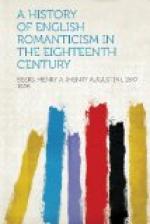[13] Poems supposed to have been written at Bristol in the fifteenth century by Thomas Rowley, Priest, etc. With a commentary in which the antiquity of them is considered and defended.
[14] “Essay on the Rowley Poems:” Skeat’s edition of “Chatterton’s Poetical Works,” Vol. II. p. xxvii.
[15] For a bibliography of the Rowley controversy, consult the article on Chatterton in the “Dictionary of National Biography.”
[16] “Ah, gentle dames! It gars me greet.”
—Tam
o’Shanter
[17] Ante, p. 350.
[18] “Chatterton. A Story of the Year 1770,” by David Masson London, 1874.
[19] “Eighteenth Century Literature,” p. 334.
[20] A recent critic, the Hon. Roden Noel ("Essays on Poetry and Poets,” London, 1886), thinks that “‘Aella’ is a drama worthy of the Elizabethans” (p. 44). “As to the Rowley series,” as a whole, he does “not hesitate to say that they contain some of the finest poetry in our language” (p. 39). The Choric “Ode to Freedom” in “Goddwyn” appears to Mr. Noel to be the original of a much admired passage in “Childe Harold,” in which war is personified, “and at any rate is finer”!
[21] See in Wm. Howitt’s “Homes of the Poets,” Vol. I. pp. 264-307, the description of a drawing of this building in 1138, done by Chatterton and inserted in Barrett’s “History.”
[22] For some remarks on Chatterton’s metrical originality, see “Ward’s English Poets,” Vol. III, pp. 400-403.
[23] Look at.
[24] Blake was an early adherent of the “Gothic artists who built the Cathedrals in the so-called Dark Ages . . . of whom the world was not worthy.” Mr. Rossetti has pointed out his obligations to Ossian and possibly to “The Castle of Otranto.” See Blake’s poems “Fair Eleanor” and “Gwin, King of Norway.”
[25] Chatterton’s sister testifies that he had the romantic habit of sitting up all night and writing by moonlight. Cambridge Ed. p. lxi.
[26] Other standard lives of Chatterton are those by Gregory, 1789, (reprinted and prefixed to the Southey and Cottle edition): Dix, 1837; and Wilson, 1869.
[27] Rowleian: there is no such instrument known unto men. The romantic love of color is observable in this poem, and is strong everywhere in Chatterton.
[28] See also the sonnet: “O Chatterton, how very sad thy fate”—Given in Lord Houghton’s memoir. “Life and Letters of John Keats”: By R. Monckton Milnes, p. 20 (American Edition, New York, 1848).
[29] Chatterton, Blake, Coleridge, Keats, Shelley. “The absolutely miraculous Chatterton,” Rossetti elsewhere styles him.
[30] “Historie du Romantisme,” pp. 153-54.
[31] “Chatterton,” a drama by Jones and Herman, was played at the Princess’ Theater, London, May 22, 1884.
CHAPTER XI.
The German Tributary




